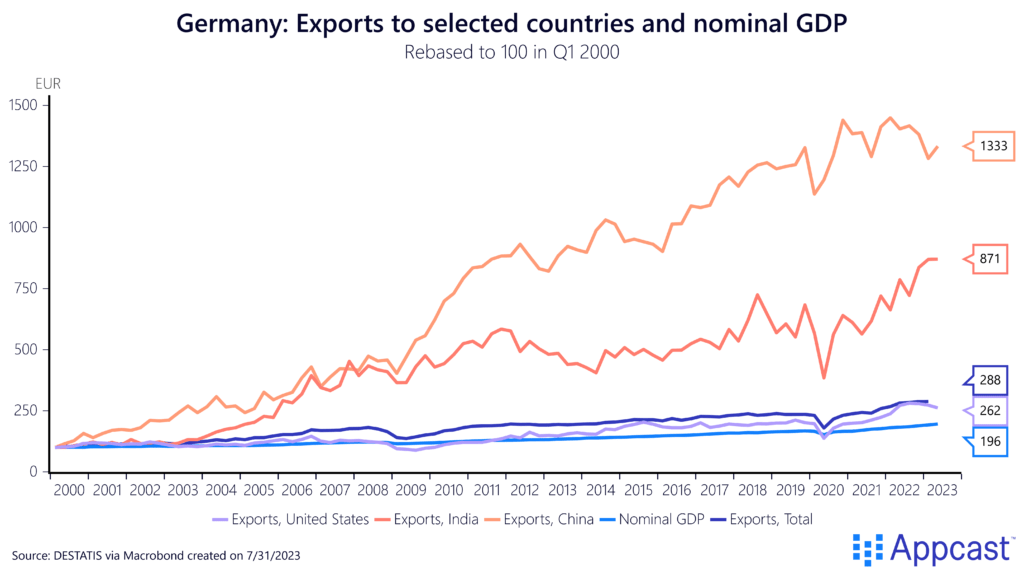Germany’s labor market reforms in the 2000s paid off
Germany was dubbed the “sick man of Europe” in the late 90s and early 2000s as the country was suffering from several years of economic stagnation together with extremely elevated unemployment rates at the time: The total number of unemployed workers reached a record high of 4.5 million in 2005.

The Hartz reforms implemented by the Schröder government between 2003 and 2005 as a response to the economic woes at the time were fundamental in transforming Germany’s labor market, which had been extremely rigid at the time. Labor laws became more flexible, and Germany’s high structural unemployment declined in the subsequent years. The reforms aimed to strengthen job-search activities, providing incentives for the unemployed to accept a job, and encourage labor force participation, notably for women and older persons. The Hartz reforms were arguably a success. Employment increased substantially in the subsequent years, even if a lot of the additional jobs were just part-time jobs initially. The number of persons working in low-paid part-time jobs increased by about a million within just a couple of years.

Economic inactivity of the working-age population also continued its steady long-term decline, almost all of it driven by more women joining the workforce. While in 1985 more than 45% of all women were still inactive, that number has now fallen to just over 20% in recent years: Four out of five women of working age belong to the active population.
Women have therefore been one of the main drivers of the employment boost in recent decades. However, the massive progress that was achieved on this front also means that we cannot count much on boosting female activity further to alleviate worker shortages.

Favorable external macro conditions boosted the German economy
Germany’s economy also recovered relatively quickly from the financial crisis, both through a combination of sheer dumb luck and smart policies. Similar to policies implemented during the COVID pandemic, German companies already implemented furlough schemes during the Great Recession when demand plummeted. The aim was to retain skilled workers and it helped German employers tremendously once global demand picked up again.
Germany also got somewhat lucky when it comes to monetary policy. The ECB was forced to run loose monetary policy for several years to combat the Eurozone crisis and support struggling Southern European economies. While ECB policy was arguably not stimulative enough for some Southern Eurozone economies, it was somewhat too stimulative for Germany in recent years, which experienced its first-in-many decades real estate price boom since the late 2010s. This is the classic “one-size-fits-all” dilemma for a large monetary union that comprises more than a dozen countries with very different local economic conditions at times.
The following chart shows that the ECB policy rate was far too low for Germany between 2014 and 2020 when compared to a standard Taylor rule – a monetary policy rule that takes into account domestic inflation and GDP growth (the output gap).

There is no doubt that low interest rates provided a boost to German house prices, which increased in real terms for the first time in decades. Inflation-adjusted house prices almost doubled between 2010 and 2020.

Germany’s manufacturing sector got a massive boost from strong global growth in the 2000s and 2010s. Surprisingly, Germany is one of the few advanced economies in which manufacturing employment increased over the last two decades. Thanks to its world-class industrial companies, Germany added more than half a million jobs in manufacturing whereas France, for example, lost roughly the same number of jobs in the sector during the same time period.

Before being overtaken by China in 2010, Germany was the largest exporting economy in the world. The country’s export sector was buoyed by strong global economic growth, especially in emerging market economies, which provided an additional boost to the German economy.
As the following chart shows, German nominal GDP increased by about 90% between 2000 and 2022. Its total exports to the rest of the world increased by about 190% over the same time, with exports to emerging markets growing even stronger: exports to India increased by a factor of 9 while exports to China grew about twelve-fold.

Taken all together, these external conditions combined with good domestic policy – structural labor market reforms – created a favorable economic environment. In the 2010s, the German economy performed better than the U.S. on a per capita basis. However, by 2017, German economic growth petered out and the economy began to stagnate even before the COVID pandemic.

There are several factors that can explain why precisely the German economy has entered such a significant slowdown. The country is increasingly affected by domestic labor shortages. External conditions have also been unfavorable: Germany has been more severely than others by the massive energy price shock. Chinese lockdowns and the country’s economic slowdown also play a role. And so does the decline in domestic car manufacturing. The reasons for Germany’s struggle are thus multifaceted and we will elaborate on each in the subsequent blog post.







